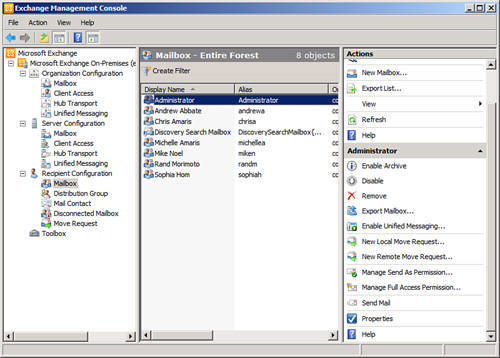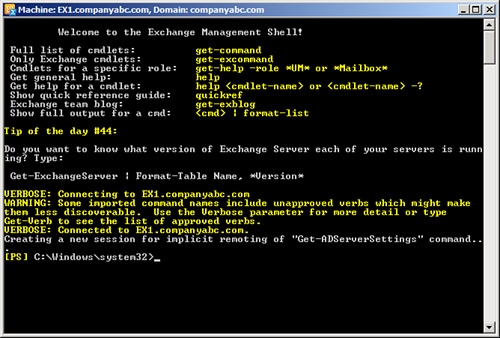Several
new and improved tools are available to administer and manage an
Exchange Server 2010 environment. There are Microsoft Management Console
snap-ins, an automation and scripting shell, and several tools native
to the Windows Server 2008 operating system
and the Exchange Server 2010 application. There is also the new
Exchange Control Panel web tool, which provides a cool role-based access
control (RBAC) administration.
The Exchange Management Console
The Exchange Management Console (EMC) shown in Figure 1
is one of the primary tools provided with Exchange Server 2010. This
utility replaces the Exchange System Manager (ESM) from Exchange Server
2000/2003 and can be used to manage Exchange Server 2010, Exchange 2007,
and Exchange Server 2003 servers in the organization.

Improvements to the console in Exchange Server 2010 include the following:
Built on Remote PowerShell with remote server administration
Role-based access control (RBAC)
Multiple forest support
Cross-premises Exchange Server 2010 management including mailbox moves between organizations
Recipient bulk edit
PowerShell command logging
New feature support such as High Availability
The
Exchange Management Console is a Microsoft Management Console 3.0
snap-in. Prerequisites for the Exchange Management Console include the
following:
A 64-bit operating system
Microsoft .NET Framework 3.5 Service Pack 1
Windows Remote Management
PowerShell v2
All of Exchange Server
2010 is 64-bit only, so all administration using the management tools is
64 bit. The management console also requires a 64-bit OS. Supported OS
platforms for the Exchange Management Console include the following:
Vista x64 SP1/2
W2k8 x64 SP2
W2k8 R2 x64
Windows7 x64
Unlike the Exchange
System Manager, which allowed administrators to access all configuration
settings of their Exchange Server 2003 environment, the Exchange
Management Console is designed to allow administrators access to common
configuration settings from the familiar graphical user interface (GUI).
However, many aspects of the environment cannot be viewed or modified
with this utility. For such configuration settings, the command line
Exchange Management Shell, which is discussed next, must be used.
The Remote Exchange Management Shell
The second utility
for managing an Exchange Server 2010 environment is an automation and
scripting tool called the Exchange Management Shell (EMS), shown in Figure 2.
This shell is a command-line management interface that can be used to
administer servers in an Exchange Server 2010 organization. It enables
administration of the Exchange Server 2010 environment without the
Exchange management tools such as the EMC, albeit via a command-line
interface. Built on Microsoft Windows PowerShell v2 technology, the
Exchange Management Shell can perform any task that can be accomplished
in the Exchange Management Console, and a lot more. In fact, many
configuration settings in an Exchange Server 2010 environment can only
be accomplished using the Exchange Management Shell.

New to Exchange Server 2010
is the ability to access all the familiar Exchange Server cmdlets
remotely, leveraging the PowerShell v2 remote capabilities. This enables
cmdlets and scripts to run across multiple servers in a single EMS
instance. It also enables administrators to run the shell from their
workstation and connect remotely to the Exchange Server 2010 servers.
Given the limitation of the Exchange Management Console to run only on
64-bit systems, the EMS also enables 32-bit clients to connect to the
servers.
The EMS does not require Exchange Server binaries to be installed on the client, making deployment much easier.
Supported client OS platforms for the Exchange Management Shell are as follows: